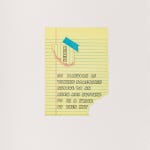Alberto Aguilar
In Alberto Aguilar’s 06.01.2024 (After 02.02.2024), the etching process is used to replicate an ordinary sheet of yellow notebook paper. At first, this use seems at odds with the technique itself, known best perhaps for the dramatic portraiture and landscapes of artists like Rembrandt or Dürer. But also, the exacting nature of etching runs counter to Aguilar’s more gestural approach to artmaking. Rooted in the practice of everyday life, his work might typically take the form of a sculpture composed of things found in one’s clutter or a line along a sidewalk drawn in bright pink petals.
For the last fifteen years, Aguilar has produced hundreds of ink drawings on yellow mini legal pads. Made in what the artist calls “in-between times,” works from the Drawing in Passing series have three subjects: self awareness through observation, illusions, and micro-revelations which are shared with the viewer.
06.01.2024 (After 02.02.2024) takes as its starting point the drawing 09.23.11. For this composition, the artist tore a corner off of the sheet of a mini legal pad and then drew its likeness on that sheet itself, fastened with a hand-drawn pin. For this print collaboration, a combination of etching and letterpress, Aguilar added to the composition in bubble-lettering: “An illusion of taking something native to an area and putting it in a place it does not belong.”
In its narrative telling and pictorial doing, 06.01.2024 (After 02.02.2024) offers an opportunity to reflect on the illusory nature of the print itself. But it also serves as a legend to Aguilar’s decades-long social practice of ushering the items of everyday life into new physical or emotional scenarios. With a politics of optimism, the artist sees his role as that of intervener, with an end goal of opening up new meanings. He says, “That's why I turn things upside down, create strange juxtapositions and use humor when arranging objects: as a way to get people to pay attention.”



